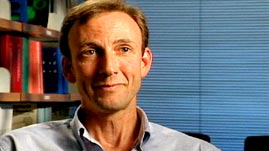The hummingbird study that Tom Smith and Chris Schneider are conducting in Ecuador is part of a much larger research program spanning three continents. Evolutionary biologists are fanning out and tramping through varying ecosystems in Africa, Australia, and South America, catching and meticulously describing the animals that live there. It's a new venture aimed at answering an old question, one that underlies all of evolutionary science: What drives the formation of new species?
The prevailing theory goes back almost 60 years, to when biologist Ernst Mayr of Harvard University proposed the "reproductive isolation" theory. When a population of, say, lizards or birds becomes divided by geographical barriers, small changes over time will alter the genetic makeup of the separated groups. Eventually, they differ enough that, should they encounter each other again, they can no longer interbreed. The offshoot group has become a new species.
But in recent years an even older, contrasting view dating back to Darwin has been gaining ground. The globe-trotting biologists are discovering an intriguing pattern: In many places, species appear to have emerged at the transition zones between different ecosystems, without ever being geographically cut off from the parent stock. They are examples of how natural selection can act through ecological differences to spawn new species.
The Andean hummingbirds are not an isolated case. The force of ecology has also been studied in the leaf-litter skink, a small lizard found in Australia. Two populations living close to each other but in different ecosystems show in their DNA that they're genetically distinct. Chris Schneider figured out that the two populations had adapted to different ecosystems -- one an open forest and the adjacent one a closed rainforest.
The open forest lizards are smaller, have shorter limbs and bigger heads, and become sexually mature earlier. The reason: Predator birds more easily pick off lizards in the open forest, so the skinks there have evolved to reproduce earlier, generating offspring before they become a bird's dinner. The genetic differences, shaped by selection, have produced two distinct species living next to each other.
And the converse can be true: Populations separated by geography but living in similar environments may be almost indistinguishable. Says Schneider: "Time and isolation alone don't necessarily result in new morphologies -- whereas a new environment does."


 Loading Standards
Loading Standards Teachers' Domain is proud to be a Pathways portal to the National Science Digital Library.
Teachers' Domain is proud to be a Pathways portal to the National Science Digital Library.
